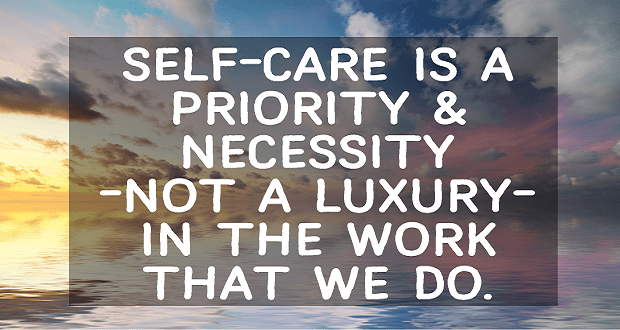
Before the start of each Winters Group session, we ask folks to commit to the following community agreement: “Center those most impacted by systems of oppression.”
Said another way: Slow down, get curious, flex that empathy muscle, and consider for a moment that what is being shared by your BIPOC colleague is true, valid, and sacred.
Why do we bring this agreement into our sessions? Because time and again many white people struggle to de-center themselves in conversations about race. Since whiteness is the default in our culture, white comfort is the unwritten rule we have been abiding by up until we name this dynamic out loud.
Now let me be clear about the way I’ll be using the term discomfort. I don’t mean: trauma, suffering, agony, physical danger, or humiliation. Frankly I believe it is irresponsible for anyone to elicit this kind of experience during a Tuesday afternoon DEIJ session (probably on the heels of yet another meeting), but it is my responsibility to hold loving space for discomfort. After all, discomfort is at the root of growth and learning.
Uncomfortable (noun): causing or feeling unease or awkwardness.
After reading the title of this article, some folks may think, “Why does this woman hate white people?” On the contrary. My life partner happens to be white. I’m biracial and in most contexts, I am white-passing. I have zero qualms with people existing in the bodies they exist in and know some truly down-for-the-cause white people who move through the world with cultural humility, self-awareness, and a lifelong commitment to shared risk.
And … we are all socialized to value, believe, honor, uphold, celebrate, and aspire to “whiteness.” What does this mean? To understand this concept, you need to understand the term white body supremacy as defined by My Grandmother’s Hands author Resmaa Menakem:
Individual and institutional attitudes, practices, and policies that elevate the white body as the standard against which all other persons’ worth is measured.
This means anti-Black racism must coexist in order for white body supremacy to thrive.
In her recent post from this Racial Justice at Work series, Natasha Crowther writes:
White people do not experience racism. No microaggressions; no casual dismissal of our lives; no heavy-handed manager being harsher to us than the rest of the team; no one making us feel like we don’t belong by asking, ‘but where are you really from?’; no ‘You’re so exotic’; no race-based discrimination from doctors, lawyers and bankers.
What’s left is the white experience — a life free from systemic racism. (And more insidiously, too often free from mention of it.) So, the white experience becomes the only one we hear about. To those of us living it, it seems universal, the standard. Our worldview becomes the only worldview. This is what white privilege is, a bubble of protection from systemic racism.
This “bubble of protection” has turned into the belief that white folks have the right to comfort, a core tenant of white supremacy culture: the belief that those with power have a right to emotional and psychological comfort.
Why can’t most white Americans lean in when conversations about race get uncomfortable? I’m not here to answer that question, but there is plenty of research about what’s going on in people’s minds, hearts, and bodies when faced with new information that challenges their fundamental belief system. It is most often subconscious and involves a whole lot of fear.
What has become increasingly clear to me, however, is the harmful impact this dynamic has on Black, Indigenous, and people of color (BIPOC). Especially when it comes from self-proclaimed “white allies.”
In my experience, here are the top 5 ways I have witnessed and/or perpetuated, the centering of white comfort:
1. Tone Policing
Many moons ago, I was facilitating an environmental justice training for 250 environmental educators in the Bay Area. As was often the case, the majority of the participants were white, and the students they served were predominantly BIPOC. At the end of the day, I welcomed closing reflections from the group. One Black woman stood up, looking out at a sea of white faces, and shared her own painful experiences of racism. The energy in the room shifted in a poignant and necessary way. And then, instead of honoring and validating her experience, I closed out the session by asking everyone to have grace for one another, recognizing this work is difficult for all of us. I unknowingly participated in tone policing. I was colluding with white supremacy culture by minimizing her experience and centering white comfort. I kept the social contract, and in return, perpetuated erasure of yet another Black woman.
Not okay.
If I could travel back to that moment, knowing what I know now, I would say something like this:
I want to acknowledge the courage it took to share your experience with us just now. What you shared is valid, it is real, and it moved me deeply. Thank you for your vulnerability. You didn’t owe us that, and it is a gift. I also want to challenge those of us in white bodies to sit with the discomfort we might be feeling right now. I invite you to reflect on what you can do in your own life to minimize harm done to those who do not look like you. This work is lifelong and I believe in our capacity to do better.
2. Trying to Get Off the Hook
Not long ago, I led a series of training sessions for a team of executives running a large philanthropic organization. One white woman in particular loved to point the finger at other white people who just “didn’t get it.” She even used the term (and I’ll never forget) “us good white people.” Yet I had repeatedly seen this woman interrupt, minimize, and undermine one of her Black colleagues. Ouch.
In her Inclusion Solution post on distancing statements, Leigh Morrison writes,
… [W]e all play a role in inequity—by benefiting from it, by upholding it, by failing to challenge it in all of the ways available to us. Of course, no one can spend every waking moment dismantling systems of oppression; this is a recipe for burnout. However, one of the best things we can do is to acknowledge this reality and recognize that for as long as inequity exists, chances are we play a role, and none of us is absolved, regardless of how ‘tuned in’ we may be.
I consider myself to be fairly tuned into the ways I benefit from privilege. At the same time, I know until I breathe my last breath, I will continue to unconsciously play a role in upholding systems of oppression. I don’t intend to, but that’s not the point. What matters is that I course-correct after messing up. Sometimes that looks like an apology and at times that looks like deep self-reflection. Other times it could mean sharing my experiences with others in hopes that they learn from my mistakes.
I have found a new sense of liberation in the fact that I don’t have it all figured out. What matters is that I never stop interrogating the ways my thought, speech, and behavior collude with white supremacy culture. And most importantly, the next time I’m tempted to point the finger at someone else, I hold up a mirror instead.
3. Non-Black People of Color Undermining Black Colleagues
Ready for yet another example of how I centered white comfort at work? I am not proud of this, and I know discomfort is where we grow.
A while back, I was shadowing an “Equity in Hiring” training led by my peer, a Black woman colleague, with the knowledge that I would be expected to lead this same training in the coming months. I was taking ferocious notes, was highly engaged, and stoked to be given the opportunity to influence faculty and staff (swoon!).
Toward the end of the session, the group was discussing various scenarios in the hiring process that could pose legal risk for the college. One of the scenarios featured a candidate who shared they recently had back surgery. After robust dialogue about how best to handle the situation, my colleague advised the group to say, “I will not take this information into consideration as I am deciding on a candidate for this position.”
From an emotional intelligence standpoint, the wording she suggested didn’t sit right with me. It felt insensitive to respond with a textbook HR answer to someone who just had major surgery. My mind was racing with alternative ways to stay within compliance while also caring for the candidate’s humanity.
And then I got perfectionistic and nit-picky. I raised my hand and challenged her on the wording, in a room full of white people (centering my own comfort in my white-adjacent body). I hadn’t considered how this would undermine her authority in an already challenging position as the only Black woman in the room. This ended up sabotaging our working relationship and ultimately, I made her look bad in front of our colleagues and betrayed her trust.
Looking back on this now, I recognize I could have discussed my thoughts privately with her in another context (for instance, during our debrief of the training). Time and place matter, and getting hung up on semantics should never take precedence over another person’s integrity. Perfectionism continues to be my Achilles heel and I have to work every day to notice when it’s bubbling up for me.
4. White Saviorism
I spent the first eight years of my career working in the youth leadership development field. The amount of centering white comfort that took place makes me cringe, and I am not exempt from participating. I call this one: “The Story of the White-Adjacent Savior.”
While serving on a “lunch and learn” committee in a former role, I was tasked with inviting a student leader of color to share their leadership journey with 300-plus faculty and staff. I knew immediately who I was going to invite. For the sake of the story, let’s call him Amir. Amir is gay, a first-generation Indian American, and beloved by all who know him. He has an easy smile, a warm demeanor, and wicked sense of humor. As a student, he was a motivated leader and someone others wanted in their corner.
I couldn’t wait to present this exciting opportunity. After I shared the details, he uncharacteristically said, “I’ll have to think about it.” I was confused. Knowing Amir, he would normally jump at an opportunity like this. Something was off.
Weeks went by, and still no answer about whether he was going to do it. Finally, after yet another nudge from me, Amir let me know that he wasn’t yet out of the closet with his family. If he were to share his story with such a large group (some of whom knew his parents), he risked being kicked out of his home.
And then it hit me. I was pushing for what I wanted, and not what Amir felt comfortable doing. I hadn’t thought to check in about any hesitancies he might have. I assumed he’d want to do it without actually asking him.
I believe it is possible for all of us to fight for racial justice in a way that doesn’t perpetuate saviorism and centering white comfort. We can ask ourselves the questions:
- Am I providing the help they want or operating from my own assumptions about what they need?
- Do I have the qualifications to do the thing that is needed?
- Am I letting them tell their own stories, on their own terms?
- Do my actions truly serve a need, or do they just make me feel better about myself?
5. Toxic Positivity
Recall a time you shared something painful with someone, and they immediately tried to get you to see the bright side. How did that feel? I’m guessing not great. When this happens to me, I feel invisible, unacknowledged, and unimportant.
The term to describe this experience is toxic positivity: the insistence that we gloss over a painful emotional experience.
Blogger Allaya Cooks-Campbell shares: Toxic positivity is actually a form of gaslighting, the term for when someone causes you to question your own sense of reality. It can cause people to dissociate themselves from their negative feelings, rationalize unacceptable experiences, and even gaslight others in turn.
In my 15 years doing this work — whether with students, educators or clients — when things get too uncomfortable for some white folks, there is a strong urge to block out the pain of what is being shared at the expense of the person who was impacted. This can also show up as folks of color silencing each other to appease the white gaze and minimize discomfort.
Toxic positivity is sneaky and ruthless. As my colleague Tami Jackson wrote in her Inclusion Solution article “Nice vs. Kind”:
Niceness is ephemeral. Niceness is often performative, niceness is subjective, and the expectations of niceness have been weaponized to silence the voices of Black women and other marginalized people in our country when we fail to make members of the dominant group feel comfortable or refuse to remain agreeable to circumstances that harm us.
When you feel the urge to respond with a “positive take” on someone’s painful experience of racism (including other intersecting “-isms” that often come with racism), take a moment to pause and consider whether your comment will validate or minimize what they are sharing.
Additionally, when you allow yourself to feel your own painful experiences, regardless of your identity, there tends to be less fear of meeting another’s pain with compassion and understanding. Instead of being threatened by the discomfort of their pain, you grow your capacity to stay present to the tension.
Closing Thoughts
If you happen to exist in a white body, and it was uncomfortable to read this article, take some time to sit with the feeling. Resist the urge to act out of guilt or shame. Invite compassion for yourself and all living beings who exist under a system that benefits some and harms others. Sit with this reality. Let your heart be broken. And the next time a Black, Indigenous, or person of color shares their story, simply believe them. Ask how you can support them. Identify how you will take on shared risk. And continue to move through the world owning your privilege with a soft heart and open mind. There’s nothing wrong with seeking comfort when you have an eye-opening experience (talk with your therapist, a mentor, a faith leader … you get the idea). Just don’t seek comfort at the expense of those who have been harmed.


















